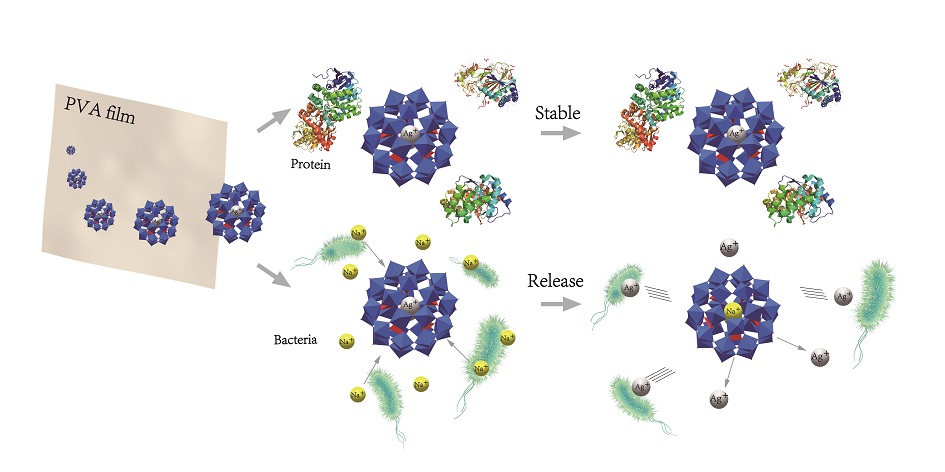Preyssler-type POMs are known as the smallest POMs accommodating a cation within their cavity. In this study, a silver-containing polyoxometalates K13Na[AgP5W30O110] are explored to control the release of silver with activation mechanism. Nuclear magnetic resonance was used to monitor the release behavior of Ag+ in the experiment. AgP5W30 is stable in aqueous solution with the presence of transferrin and common metal ions that are rich in biological fluids, but releases Ag+ based on the ions exchange between Ag+ and Na+. The release rate of Ag+ is close to 100% when the molar ratio of Na+ to AgP5W30 exceeds 14:1. Moreover, the ions exchange reaction shows a high degree of selectivity to Na+, rather than Ca2+ or Zn2+. In subsequent resistance tests of Escherichia coli andStaphylococcus aureus, AgP5W30 also showed good anti-resistance, and the minimum inhibitory concentrations (MICs) remained unchanged for 20 incubation cycles, while the MICs of silver nanoparticles expanded at least 5 times after 9 incubation cycles. In addition, the AgP5W30-PVA composite films were prepared by the solution casting method. When the amount of AgP5W30 was 3% (w/w), the tensile strength of the composite film increased by 26.14%, and the elongation at break decreased by 6.59%, without significant change in thermal stability and surface morphology. In the test of inhibition zone, the composite films also showed good bacteriostatic effects for both both Escherichia coli andStaphylococcus aureus. Application of silver-containing polyoxometalates provides an effective method on controlled release of silver ions to fight against bacterial resistance.Few cases realize the controlled release based on the inorganic materials, especially for release with activation mechanism, it is also the first case for polyoxometalates used in ions-controlled release.
Preyssler是已知具有容纳阳离子空穴的最小多酸结构。本研究通过水热法合成了Preyssler型多酸K13Na[AgP5W30O110] (AgP5W30),并通过核磁共振研究了该多酸中银离子的释放以及该多酸对大肠杆菌和金黄葡萄球菌的最小抑菌浓度。实验发现AgP5W30能在常见离子及蛋白质水溶液中保持结构稳定,并通过与钠离子的交换实现空穴中银离子的可控释放,当钠离子与AgP5W30的摩尔比超过1:14时,银离子释放率接近100%。与钙离子和锌离子相比,该离子交换反应体现出对钠离子高度的选择性。在后续对大肠杆菌以及金黄葡萄球菌的耐药性测试中,AgP5W30也体现出良好的抗耐药性,其最小抑菌浓度在20个孵育周期中保持不变,而银纳米粒子的最小抑菌浓度在经历了9个孵育周期后至少扩大了5倍。此外,通过溶液浇铸法制作了AgP5W30-聚乙烯醇复合膜,当AgP5W30的添加量为3% (w/w)时,复合膜的抗拉强度提高26.14%,断裂伸长率降低6.59%,且复合膜热稳定性及表面形貌无明显变化。在抑菌圈实验中,复合膜同样体现出良好的抑菌效果。非常有限的案例通过无机材料实现控释,对多酸而言,这也是其首次应用于控释领域中。

文章链接:https://pubs.rsc.org/en/content/articlelanding/2020/cc/d0cc01676d#!divAbstract

